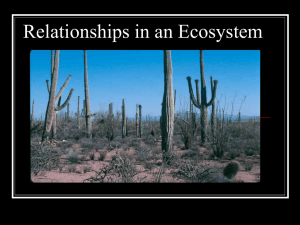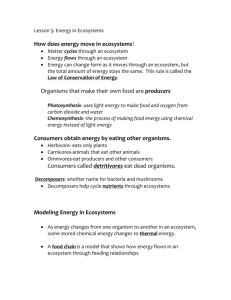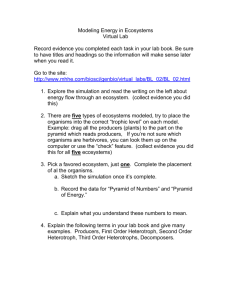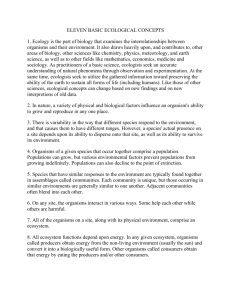End of Year * Science Study Guide
advertisement
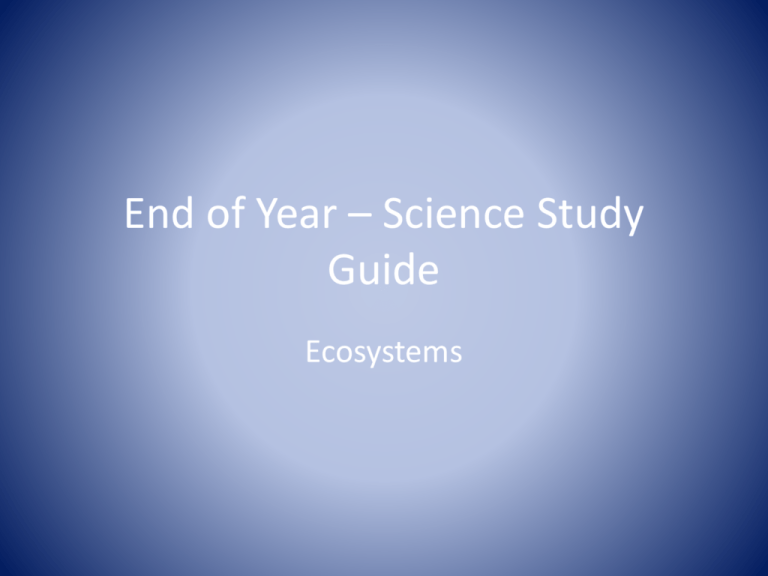
End of Year – Science Study Guide Ecosystems Ecosystems • Ecosystem – all the living and non-living things in an area/environment • Biotic Factors – all the living things in an ecosystem • Abiotic Factors – all the non-living things in an ecosystem • All life starts with the major energy source, which is the sun. Producers Producers are… • A living thing that makes it’s own food Some examples include… • Plants, such as grasses, shrubs, and trees • Algae and elodea (types of bacteria) can also be producers Their role in an ecosystem… • Provide oxygen for other organisms • Pass energy on to consumers when eaten Producers • How do producers produce energy? Producers make their own food through photosynthesis. Plants take in carbon dioxide (through their leaves) and water (from the soil) and use sunlight to change them into oxygen gas and sugar (stored energy). Carbon Cycle Plants Oxygen Carbon Dioxide Animals, Humans Consumers Consumers are… • A living thing that gets energy by eating other living things Some examples include… • Humans, mice, rabbits, deer, sharks, wolves, lions, etc. Their role in an ecosystem… • Produce carbon dioxide for plants • Eat plants – keep plant population in check • Pass energy to decomposers Three Types of Consumers Herbivores – eat only or mostly plants • Mice, rabbits, deer, elephants, cows, zebras, and insects Omnivores – eat both plants and animals • Pigs, bears, raccoons, and humans Carnivores – eat only animals • Sharks, lions, wolves, hawks, foxes, and cats Energy Pyramid Tertiary Consumers Carnivores/Omnivores Secondary Consumers Carnivores/Omnivores Primary Consumers Herbivores Producers Decomposers Decomposers are… • Living things that get energy from breaking down wastes and dead plants and animals Some examples include… • Mushrooms (fungi), worms, bacteria, and termites Their role in an ecosystem… • Break down dead organisms • Add nutrients to the soil • Pass energy back to producers Food Chain • A model that shows the path of energy as it flows from one living thing to another Grass Producer Grasshopper Consumer Snake Consumer Hawk Consumer Fungi Decomposer Food Web • Multiple food chains that show the connectedness of species within an ecosystem Other Organisms Scavengers – carnivores that look for dead animals for their food source (hyenas, buzzards) Parasites – organisms that depend on another organism for their survival (fleas, ticks, roundworms) Predator – the hunter (lion) Prey – the hunted (zebra) Niche – an organism’s role/job within the ecosystem Aquatic Ecosystems Lakes/Ponds • Bodies of freshwater surrounded by land on all sides • Some organisms include: plants, algae, snails, frogs, turtles, ducks, catfish, bass, trout and beavers Oceans • Large bodies of saltwater divided by continents. Have many types of ecosystems. • Some organisms include: seaweed, jellyfish, fish, crabs, corals, whales, sharks, octopuses Aquatic Ecosystems Estuary • A body of water where freshwater from rivers mixes with saltwater from oceans. • Some organisms include: shrimp, crabs, egrets, muskrats, blue herons, and turtles. Salt Marsh • A flat area of land that saltwater overflows • Some organisms include: pond lilies, cattails, amphibians, reptiles, and crawfish Terrestrial Ecosystems Grassland/Savanna • A biome with moderate temperatures and light rainfall where grasses (not trees) are the main plant life • Wildflowers, mostly grasses, elephants, zebras, giraffes, warthogs Desert • A sandy, rocky and arid biome with little rain and plant life (extreme heat and extreme dryness) • Organisms: cacti, lizards, rattlesnakes, jackrabbits • Plants and animals have adaptations to help them retain water Terrestrial Ecosystems Tropical Rainforest: • a hot, wet biome near the equator that receives lots of rainfall • Greatest variety of plant and animal life • Four levels of plant life: emergents, canopy, understory, forest floor (very little sunlight) Taiga/Coniferous Forest • A cool forest biome of coniferous trees in the upper Northern Hemisphere • Evergreen trees (spruce, fir, hemlock), moose, wolverine, and snowshoe rabbit Terrestrial Ecosystems Tundra: • large, treeless plain in the arctic regions where the ground is frozen all year (Permafrost) • Small plants close to the ground (cushion plants, lichens), arctic fox, polar bears Temperate/Deciduous Forest • Moderate temperatures and rainfall levels based on Earth’s rotation (changing seasons) • Deciduous trees (lose their leaves in the fall), mosses, shrubs, ferns, deer, foxes, raccoons, rabbits

